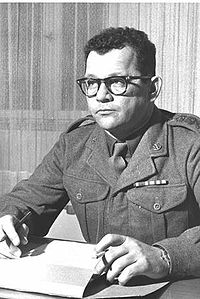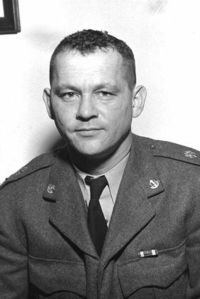- Haim Laskov
-
Haim Laskov 
Chaim Laskov in 1958Born 1919
Barysaw, Byelorussian Soviet Socialist RepublicDied 1983
IsraelAllegiance British Army
Haganah
Israel Defense ForcesYears of service 1932–1965 Rank Lieutenant General
Chief of StaffBattles/wars World War II
1948 Arab-Israeli War
Suez CrisisHaim Laskov (1919, Barysaw, Byelorussian Soviet Socialist Republic – 8 December 1983) was an Israeli public figure and the fifth Chief of Staff of the Israel Defense Forces.
Contents
Early life
Laskov was born in Barysaw in what had just become the Byelorussian Soviet Socialist Republic (present-day Belarus) and emigrated to Palestine with his family in 1925. The family settled in Haifa, where they lived in dire poverty. Laskov's father was killed by Arabs in 1930.
Laskov joined the Haganah as a teenager, and served in various units, including Orde Wingate's Special Night Squads. He also served as a personal messenger for Yaakov Dori, who would later become the first Chief of Staff. In 1940, Laskov joined the British Army so that he could participate in World War II. He served in various capacities, and was a commander of the Jewish Brigade which saw action on the Italian front, eventually reaching the rank of major. After the war, he remained in Europe to participate in the Aliyah Bet illegal immigration effort to bring refugee Jews to Palestine. He also took part in various illicit acts of vengeance against the Nazis and their collaborators. Upon eventually returning to Palestine, he rejoined the Haganah, while also working as chief of security for the electric company.
Military career
When Israel's War of Independence erupted in 1948, Laskov assumed responsibility for preparing the framework in which new recruits would be trained. He organized the first officers' course, and formed the graduates into a brigade that fought at Latrun during Operation Nahshon.[1] One month later, in May 1948, he returned to Latrun as commander of Israel's first armored battalion, which fought alongside the 7th Brigade. He commanded the entire brigade during Operation Dekel and Operation Hiram, and participated in the many battles over control of the Galilee. In July, he finally returned to training new recruits, now with the rank of major general.
Although he had never been a pilot, Laskov was appointed commander of the Israeli Air Force in 1951. During his tenure, the air force prepared to incorporate its first jet fighter, the Meteor. Upon completing his tenure in 1953, Laskov left the army to study philosophy, economics, and political science (PPE) in the United Kingdom. He also obtained additional military training there.
In 1955, he returned to Israel, where he was appointed Deputy Chief of the General Staff and Senior Staff Officer, however, after a series of professional disputes with Moshe Dayan, he was demoted to Commander of the Armored Corps. During the 1956 Sinai Campaign, he commanded the 77th Division, which operated on the Rafah-el-Arish-Kantara front. Upon the death of Asaph Simchoni, Chief of the Southern Command, in a plane crash, Laskov assumed his position, and oversaw the withdrawal of Israeli troops from the Sinai Peninsula.[1]
Chief of General Staff
In 1958, Laskov was appointed Chief of General Staff, replacing Moshe Dayan. His appointment took place against the backdrop of the unification of Egypt and Syria as the United Arab Republic on January 31 of that year and the potential threat this posed to the security of Israel. Just two months later, on March 30, Israel and Syria exchanged heavy artillery fire across the Sea of Galilee. The clashes lasted for two days, until a ceasefire was finally achieved.
On April 24, Laskov presided over a huge military parade in Jerusalem to mark the tenth anniversary of Israel's independence. This took place despite warnings by Jordan that such a parade would be considered an act of aggression. During the parade, Laskov displayed Israel's latest military hardware, including weapons captured from Egypt in the Sinai and from Syria during clashes in the Hula Valley.
On November 6, Syria resumed its artillery bombardment of the Galilee, while Israeli workers were involved in a massive project draining Lake Huleh to obtain more agricultural land for the country. Under Laskov's orders, the IDF returned fire.
One of the great scandals that occurred during Laskov's tenure, was a surprise exercise to test the mobilization of the reserves, on April 1, 1959. Known as the "Night of the Ducks" (one of the coded call-up signals broadcast over the radio was "Water Fowl"), the event caused panic throughout the country, and put the armies of the neighboring Arab states on high alert. A commission of inquiry which investigated the matter found Major General Meir Zorea, Senior Staff Officer, and Major General Yehoshafat Harkabi, Chief of Military Intelligence, responsible for the fiasco, and the two resigned their posts.
Tensions between Israel and Syria continued over the following months. On January 31, Israel attacked the Syrian village of Tawfik, overlooking the Sea of Galilee, claiming that it had been used by the Syrian army to bombard Israeli villages in the Galilee. Three Israeli soldiers were killed in the operation.
 The Agranat Commission; Left to right: Yigael Yadin, Moshe Landoi, Shimon Agranat, Yitzchak Nebenzahl, and Chaim Laskov (1973)
The Agranat Commission; Left to right: Yigael Yadin, Moshe Landoi, Shimon Agranat, Yitzchak Nebenzahl, and Chaim Laskov (1973)
Laskov resigned his position of Chief of General Staff after a relatively peaceful tenure, marred only by clashes with the Syrians. During his term, he focused on building the strength of the IDF: Israel acquired its first submarine and its Super Mystère jets. Just before he left office, prime minister David Ben Gurion also announced that the country had built a nuclear reactor outside the desert town of Dimona. The reactor, he claimed, was built for peaceful purposes.
Civilian career
In 1961, Laskov was appointed Director General of the Ports Authority, and it was during his tenure that the port of Ashdod, now Israel's major port, was constructed. He also continued to write military training manuals and submitted numerous articles to military journals. In 1972, Laskov became the country's first Soldier's Ombudsman, a post he held for ten years, until his death. After the Yom Kippur War in 1973, he served on the Agranat Commission that investigated the fiascos that led to the war.
References
- ^ a b Cohen, Eliezer (1993). Israel's Best Defense. New York: Orion Books. pp. 504. ISBN 0-517-587904.
See also
Israeli Air Force Commanders  Amir (1948) · Remez (1948–50) · Shamir (1950–51) · Laskov (1951–53) · Tolkovsky (1953–58) · Weizman (1958–66) · Hod (1966–73) · Peled (1973–77) · Ivry (1977–82) · Lapidot (1982–87) · Ben-Nun (1987–92) · Bodinger (1992–96) · Ben Eliyahu (1996–2000) · Halutz (2000–04) · Shkedi (2004–08) · Nehoshtan (2008–)
Amir (1948) · Remez (1948–50) · Shamir (1950–51) · Laskov (1951–53) · Tolkovsky (1953–58) · Weizman (1958–66) · Hod (1966–73) · Peled (1973–77) · Ivry (1977–82) · Lapidot (1982–87) · Ben-Nun (1987–92) · Bodinger (1992–96) · Ben Eliyahu (1996–2000) · Halutz (2000–04) · Shkedi (2004–08) · Nehoshtan (2008–)
Heads of Southern Command  Allon (1948–49) · Rabin (1949) · Dayan (1949–51) · Tzadok (1951–54) · Peri (1954) · Amit (1955–56) · Simhoni (1956) · Laskov (1956–58) · Herzog (1958) · Yoffe (1958–62) · Zamir (1962–64) · Gavish (1965-69) · Sharon (1969-73) · Gonen (1973) · Bar-Lev (1973) · Tal (1973-74) · Adan (1974) · Adam (1974–76) · Shapir (1976–78) · Shomron (1978–82) · Erez (1982–83) · Bar Kokhva (1983–86) · Sagi (1986) · Mordechai (1986–89) · Vilnai (1989–94) · Mofaz (1994–96) · Yanai (1996–97) · Samia (1997–2000) · Almog (2000–03) · Harel (2003–05) · Galant (2005–2010) · Russo (2010–)
Allon (1948–49) · Rabin (1949) · Dayan (1949–51) · Tzadok (1951–54) · Peri (1954) · Amit (1955–56) · Simhoni (1956) · Laskov (1956–58) · Herzog (1958) · Yoffe (1958–62) · Zamir (1962–64) · Gavish (1965-69) · Sharon (1969-73) · Gonen (1973) · Bar-Lev (1973) · Tal (1973-74) · Adan (1974) · Adam (1974–76) · Shapir (1976–78) · Shomron (1978–82) · Erez (1982–83) · Bar Kokhva (1983–86) · Sagi (1986) · Mordechai (1986–89) · Vilnai (1989–94) · Mofaz (1994–96) · Yanai (1996–97) · Samia (1997–2000) · Almog (2000–03) · Harel (2003–05) · Galant (2005–2010) · Russo (2010–)
Deputy Chiefs of Staff of the Israel Defense Forces 
Tzvi Ayalon (1948–49) · Mordechai Maklef (1949–52) · Haim Laskov (1955–56) · Tzvi Tzur (1958) · Yitzhak Rabin (1961–63) · Haim Bar-Lev (1967–68) · Israel Tal (1973) · Yekutiel Adam (1978–82) · Moshe Levi (1982–83) · David Ivry (1983–85) · Dan Shomron (1985–86) · Amir Drori (1986–87) · Ehud Barak (1987–91) · Amnon Lipkin-Shahak (1991–94) · Matan Vilnai (1994–97) · Shaul Mofaz (1997–98) · Uzi Dayan (1998–99) · Moshe Ya'alon (1999–2002) · Gabi Ashkenazi (2002-04) · Dan Halutz (2004–05) · Moshe Kaplinsky (2005–07) · Dan Harel (2007–09) · Benny Gantz (2009–10) · Yair Naveh (2010–present)
Chiefs of Staff of the Israel Defense Forces 
Yaakov Dori (1947–49) · Yigael Yadin (1949–52) · Mordechai Maklef (1952–53) · Moshe Dayan (1953–58) · Haim Laskov (1958–61) · Tzvi Tzur (1961–64) · Yitzhak Rabin (1964–68) · Haim Bar-Lev (1968–72) · David Elazar (1972–74) · Mordechai Gur (1974–78) · Rafael Eitan (1978–83) · Moshe Levi (1983–87) · Dan Shomron (1987–91) · Ehud Barak (1991–95) · Amnon Lipkin-Shahak (1995–98) · Shaul Mofaz (1998–2002) · Moshe Ya'alon (2002–05) · Dan Halutz (2005–07) · Gabi Ashkenazi (2007–2011) · Benny Gantz (2011–present)
Categories:- Chiefs of Staff of the Israel Defense Forces
- 1919 births
- 1983 deaths
- People from Barysaw
- Belarusian Jews
- People of the Suez Crisis
- Jews in Ottoman and British Palestine
- Israeli people of Belarusian origin
Wikimedia Foundation. 2010.

